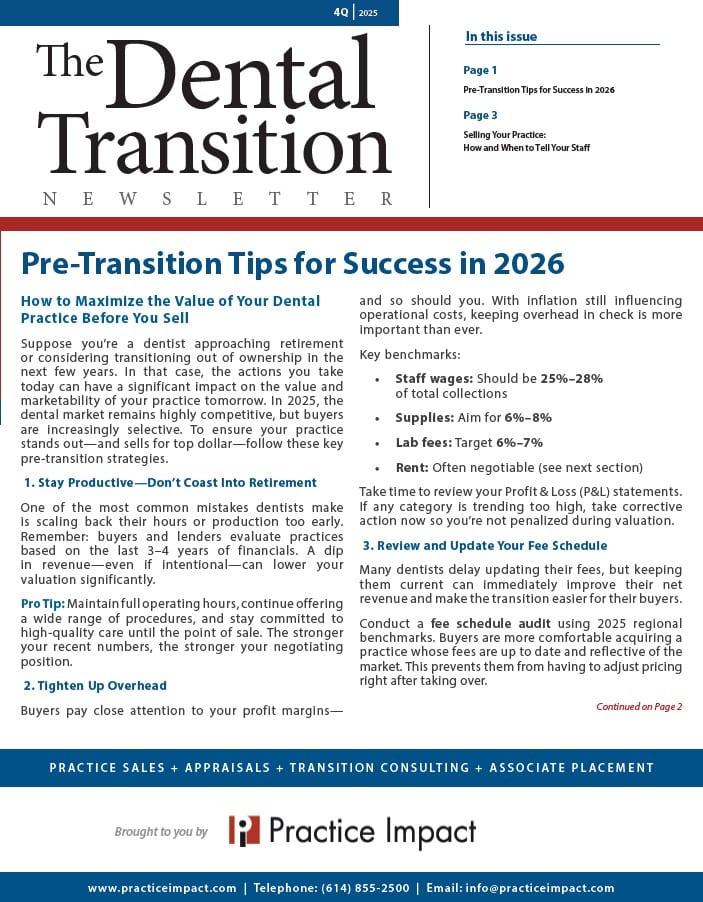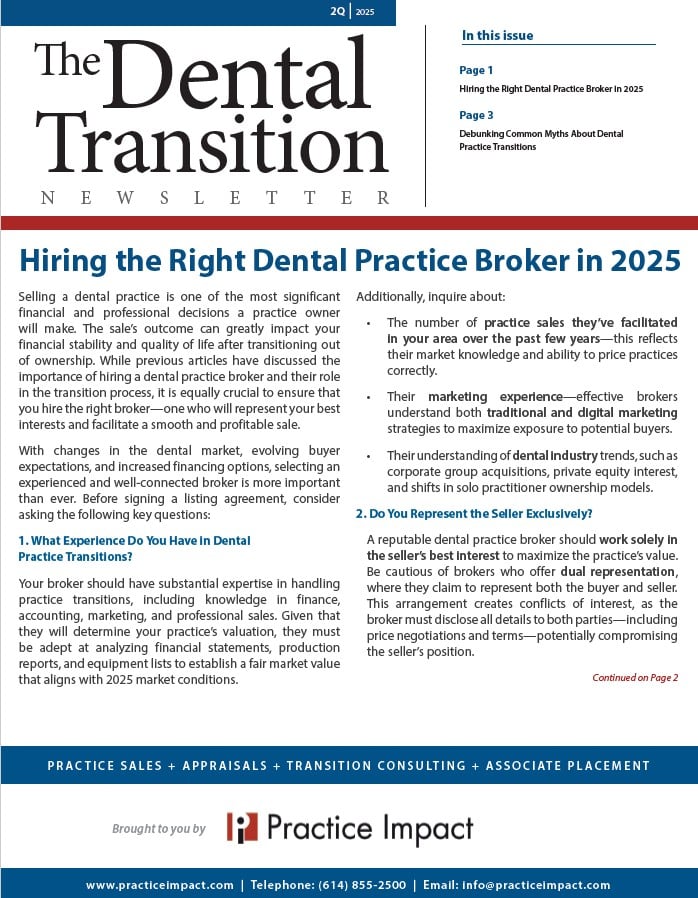FAQ When Adding an Associate to your Dental Practice
Frequently Asked Questions When Making the Decision to Add an Associate to your Dental Practice
1. What are the signs that a dentist needs an associate?
A dentist is typically ready to add an associate to the practice when the number of active patients exceeds 2,000 in a general practice, 4,000 in a pedo practice and over 250 active cases in an ortho practice. Generally, if the dentist is booked 4-6 weeks ahead (counting the next appointment only, not a booked treatment plan), then the practice needs a second dentist. The practice should however, take into account the Return on Investment (ROI) and project the financial outcome of adding an associate for both the owner of the practice and the associate.
· How are the new patients handled?
Usually the practice agrees to provide patients from the new patient source and from existing patients in the practice. The associate is also responsible for actively assisting in securing new patients. The practice should instruct the business office to assign a percentage of all new patients that did not request a specific dentist to the associate. New patients brought in by a specific dentist should, if possible, be scheduled to that dentist.
· Who owns the patient records?
The practice owns all of the patient records. The practice shall provide access to the records of the patients the associate treats, but the associate is not entitled to general access to the other patient records.
2. What is the typical compensation for an associate?
Most of the time an associate is not paid a specific salary or hourly wage, but is paid a percentage of his/her production or collections. The average compensation for a general dentist is 30% -35% and this should be determined by thinking about the practice’s overhead and ROI. If the associate is being paid a percentage of production, then the practice needs to be even more concerned about patients making financial arrangements before the work is done, especially if the practice has a high AR. If the practice is managed well this should be a non-issue because collections will be at a level of at least 97%. The practice should, however, always guard against the associate setting up a treatment plan without financial arrangements being made. The practice should make this a requisite in the office policy manual.
· How are the expenses handled? `
The practice should pay all normal business expenses including rent, utilities and the cost of reasonable dental supplies. In addition the Practice will furnish adequate dental equipment and instruments and have one operatory available at all times for the associate and other operatories available by schedule. The practice should also furnish a full time assistant and access to the hygiene schedule for the associate as well as full support of the business office staff.
The associate is responsible for the cost of personal liability insurance and a percentage of the laboratory bill. This amount if usually a sliding scale determined by the percentage of compensation that the associate receives. If the associate receives more than 35% in compensation then it usually means that the associate will pay part of the lab bill. If the associate receives 40% in compensation then the associate will usually pay the entire lab bill.
· What percentage of the Hygiene fee does the associate receive?
The associate will receive only the agreed upon percentage of the exam fee.
· Are most associates paid a draw on the first months of employment? We have three examples to answer this question:
o Sometimes there is a 3-4 month option where the associate is paid a draw of future compensation while working to build their production. This agreed upon amount is usually the minimum needed by the associate for living expenses. The associate agrees to pay back any draw not earned if employment is terminate for any reason.
o Sometimes agreements will provide 3 -4 months’ salary before compensation is based on percentage of production. This is determined to be a salary and not a draw of future compensation.
o Agreements can also provide the associate with a base salary plus commission during the trial period (typically the first 90 days of employment).
· What is the difference between an independent contractor and an employee?
o An Independent Contractor usually means that the associate furnishes their own equipment and supplies, controls their employees and owns their practice. Owner of the facility does not deduct taxes form worker’s compensation and is not responsible for loses or damages of the independent contractor. The Independent Contractor will be responsible for payment of the use of the facility and is responsible and profits from all collections of fees for services they perform.
o Employee status is usually determined by the Practice furnishing the associate with equipment, materials and employees needed for performance. The Practice assumes liability stemming from worker’s performance, determines working methods and conditions and is responsible for deduction of taxes from worker’s compensation. Associate employee should expect and negotiate up front for typical employee benefits.
3. Are most associates required to sign a restrictive covenant?
As an employee, the associate usually signs an agreement that states, if employment is terminated for any reason, by either the associate or the Practice, the associate agrees not to engage, directly or indirectly, in the practice of dentistry whether as a proprietor, partner or employee within an agreed amount of miles from the Practice for a determined number of years. Either party is usually required to provide a ninety day written notice of termination of agreement of employment.
· What are the usual mileage restriction? Typically this is between 5 – 10 miles, depending on the population concentration of the area. The higher the population, the less miles in the restriction.
· What is the usual time restriction? 5 Years
· What happens is the restrictive covenant is violated? The contract usually states that the Practice is entitled to obtain injunction relief to prohibit such violations and obtain monetary damages for any injury to the Practice resulting from such competition.
4. If Buy-In options are discussed, when should the practice be evaluated for its appraised value?
There are basically two distinct goals in bringing on an associate; one is to relieve the patient load and assist with the existing production projection; second is to find a readymade buyer of the existing practice. If the main goal is to find an appropriate transition within the next two years then the value of the practice should be determined prior to the associate’s impact on the practice. If the Practice is looking for an employee to assist in production only and no transition is planned for the next five years, then the Practice should be evaluated only when the employee decides to invest in a buy-in.
If you are looking for any kind of associate, need a valuation for an associate you have already found, or need help putting together the deal for your buy-in, contact Practice Impact. We can help!





